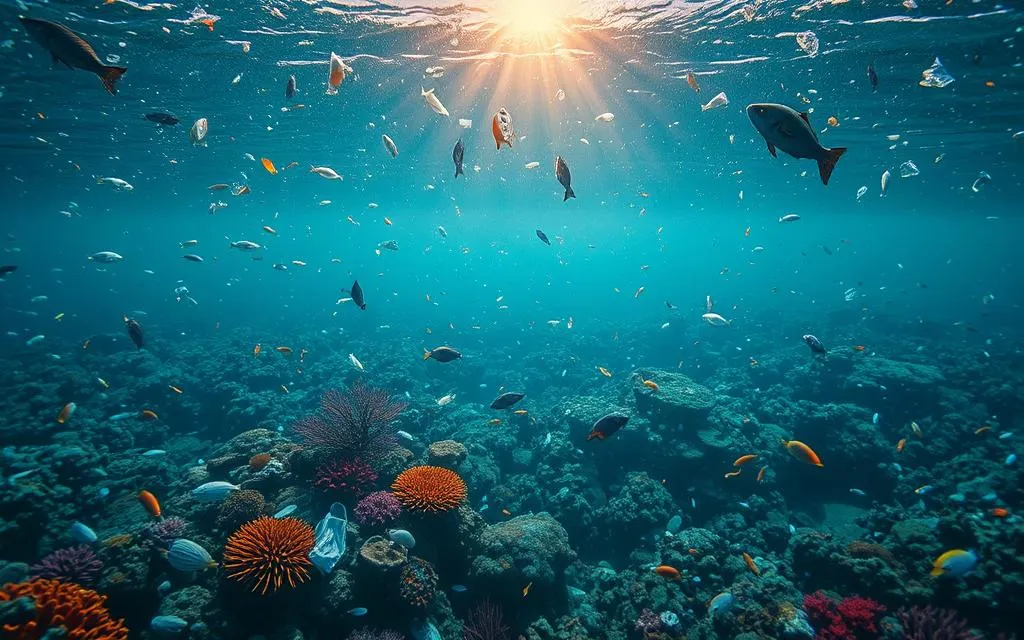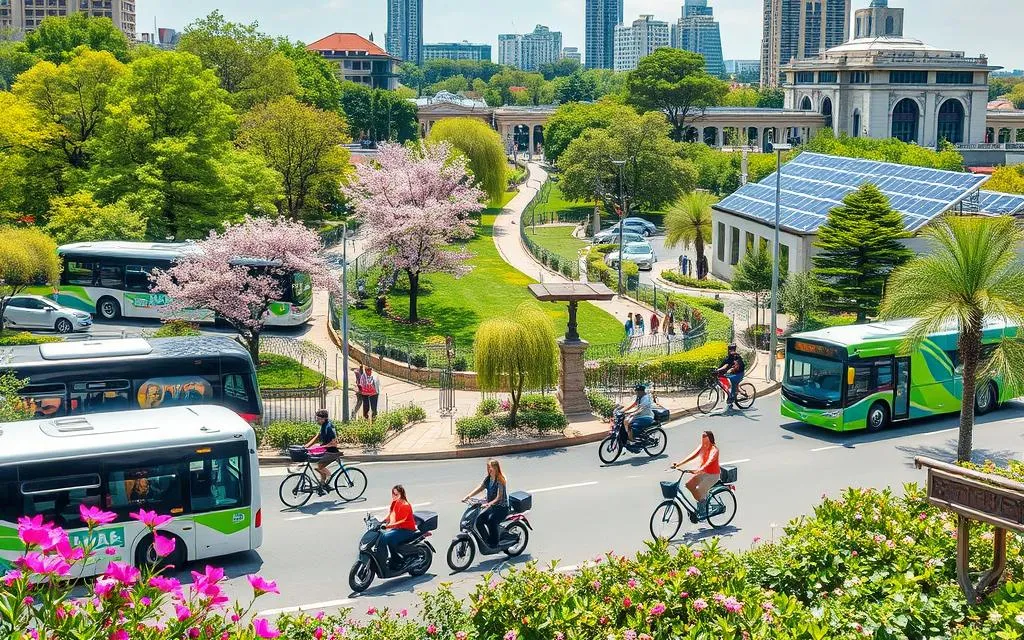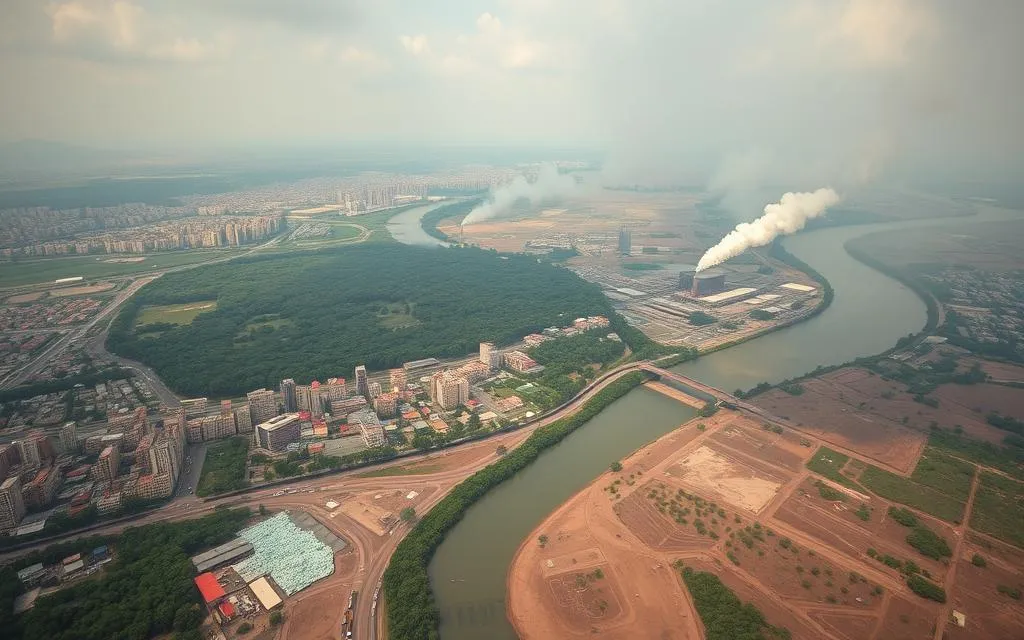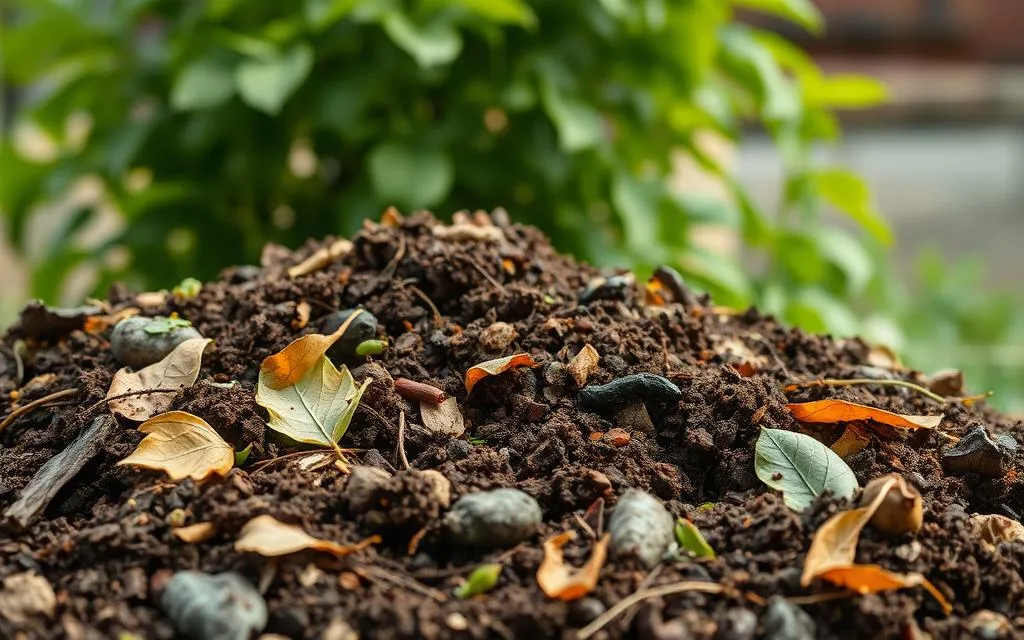Learn how are humans impacting the environment from pollution to deforestation Discover solutions to reduce harm and protect the planet.
We often wonder how our actions affect the environment. It’s easy to overlook the impact we have on the planet. But, what is the true extent of our environmental impact?
Exploring how humans affect the environment shows us its complexity. Our actions, from climate change to pollution, deeply impact the planet. It’s a pressing issue that needs our attention and action.
As we look into how humans impact the environment, we see many ways. Understanding our impact helps us make changes. We can work towards a more sustainable future.
Table of Contents
ToggleUnderstanding the Scale of Human Environmental Impact
We must grasp the scale of human environmental impact to tackle our challenges. This means measuring our global footprint and tracking key environmental signs. By doing this, we can spot where human actions most harm the environment.
Our global footprint is a big worry, with human actions affecting ecosystems everywhere. To get a clearer picture, we can look at signs like greenhouse gas emissions, deforestation rates, and pollution levels.
Measuring Our Global Footprint
To measure our global footprint, we need to analyze data on human activities and their environmental effects. This includes the impact of industrial processes, transportation, and farming on the environment.
Key Environmental Indicators
Some important environmental indicators include:
- Greenhouse gas emissions
- Deforestation rates
- Pollution levels
These indicators help us see the human environmental impact and find ways to improve.
Recent Impact Trends
Recent trends show human environmental impact is growing, with more greenhouse gas emissions and deforestation. To tackle this, we must work together to lessen our global footprint and lessen the harm of human activities on the environment.
The Rising Tide of Climate Change
Global temperatures are rising fast, causing big environmental problems. Climate change is a major issue today, leading to melting glaciers and rising sea levels. Human actions like burning fossil fuels and cutting down trees are main causes.
Some key factors include:
- Greenhouse gas emissions from industrial activities
- Deforestation and land-use changes
- Agricultural practices and livestock production
It’s important to understand climate change to find ways to lessen its effects. By cutting down on carbon emissions and using renewable energy, we can help the planet. This way, we can make our future more sustainable and reduce climate change’s harm.
Deforestation and Habitat Loss in Numbers
Human activities like agriculture, urbanization, and logging are causing big problems. Deforestation and habitat loss are harming our planet a lot. It’s important to look at the numbers to see how bad it is. The Amazon rainforest, full of life, shows us the damage.
Every year, millions of hectares of forest are lost. This leads to deforestation and habitat loss, hurting biodiversity. We must act fast to save our forests and the animals that live there.
Amazon Rainforest Case Analysis
The Amazon rainforest is key to our ecosystem, giving us oxygen, food, and homes for many animals. But, it’s under threat from deforestation. Millions of hectares are lost each year, harming biodiversity and putting many species at risk.
Global Forest Coverage Decline
The world’s forests are shrinking, and we need to act quickly. Here’s a table showing how much forest area has decreased over the years:
| Year | Forest Coverage (million hectares) |
|---|---|
| 1990 | 4,128 |
| 2000 | 3,961 |
| 2010 | 3,854 |
| 2020 | 3,744 |
Impact on Biodiversity
Deforestation and habitat loss are very bad for biodiversity. Many animals are losing their homes and facing extinction. We must protect our forests and biodiversity. Here are some of the main problems:
- Loss of species
- Disruption of ecosystems
- Climate change
Ocean Pollution: A Growing Crisis
Ocean pollution is a big problem that harms our planet. Things like plastic waste, oil spills, and overfishing hurt marine life. We must spread the word and find ways to reduce pollution and protect marine life.
Some major causes of ocean pollution include:
- Plastic waste: Plastic bags, bottles, and microbeads pollute our oceans and harm marine life.
- Oil spills: Oil spills from ships and offshore drilling damage marine ecosystems.
- Overfishing: Overfishing depletes fish populations and harms marine ecosystems.

The effects of ocean pollution are wide-reaching. We must act to solve this environmental crisis. By using less plastic, supporting sustainable fishing, and promoting marine conservation, we can protect our oceans and the health of our planet.
| Causes of Ocean Pollution | Effects on Marine Ecosystems |
|---|---|
| Plastic waste | Harm to marine life, pollution of the food chain |
| Oil spills | Destruction of habitats, damage to marine ecosystems |
| Overfishing | Depletion of fish populations, damage to marine ecosystems |
How Are Humans Impacting the Environment Through Industrial Activities
Industrial activities harm the environment a lot. They cause pollution and damage. We’ll look at how the manufacturing sector, a big polluter, affects our planet.
Manufacturing Sector Analysis
The manufacturing sector plays a big role in pollution. Many of its processes use fossil fuels, leading to a lot of carbon emissions. To lessen harm, using cleaner tech and saving energy are key steps.
Carbon Emission Trends
Carbon emissions from industries keep going up. This is a big danger to our planet. By studying these trends, we can find ways to cut down emissions and protect the environment.
Industrial Waste Management
Managing industrial waste well is crucial. Practices like recycling and proper disposal can greatly reduce waste. This helps lessen the harm caused by industries.
To lessen the harm of industrial activities, we need a broad approach. This includes cutting carbon emissions, managing waste better, and using energy more efficiently. Together, we can make industries more sustainable and secure a better future.
Urban Development and Ecosystem Disruption
As we keep growing cities, we must think about how it affects nature. Building more cities and roads harms natural places. This leads to a loss of different species and more pollution.
Some major ways cities harm the environment include:
- Loss of green spaces and natural habitats
- Increased air and water pollution
- Climate change due to increased energy consumption and greenhouse gas emissions
It’s important to understand how cities affect nature. This knowledge helps us plan cities better. We can make cities greener and healthier for people and nature.
Urban growth and nature harm are connected. We need to tackle these problems to lessen city’s environmental impact. We aim for a balance between city growth and nature protection for a better future.
Agricultural Practices and Environmental Stress
Agricultural practices play a big role in environmental stress. They affect soil quality, water resources, and biodiversity. Modern farming, with pesticides and fertilizers, is a major concern. We need to find ways to make farming more sustainable for the environment and our health.
Integrating sustainable agriculture into farming can help lessen environmental stress. Practices like crop rotation, organic farming, and precision agriculture reduce pesticide and fertilizer use. This helps protect soil and water and boosts biodiversity and ecosystem services.
Modern Farming Impact Assessment
It’s important to assess the impact of modern farming. We need to look at monoculture farming, irrigation, and GMOs. This helps us find ways to make farming less harmful to the environment and promote sustainability.
Pesticide Use Consequences
Pesticides have big environmental and health risks. They can pollute soil, water, and air, harming wildlife and people. Pesticide-resistant pests can lead to more pesticide use, making the problem worse. We need to find better ways, like IPM and organic farming, to reduce pesticide use.
By choosing sustainable farming, we can lessen environmental stress and improve our food system. It takes teamwork from farmers, policymakers, and consumers to make sustainable agriculture a priority. This helps protect our environment and ensures healthier food for everyone.
Transportation’s Environmental Footprint
Transportation has a big impact on our environment. Burning fossil fuels and vehicle emissions cause air pollution and climate change. We need to find ways to make transportation more sustainable.
Here are some important areas to work on:
- Electric or hybrid vehicles, which reduce reliance on fossil fuels
- Public transportation, offering an efficient way to move large numbers of people
- Non-motorized transportation options, such as cycling or walking, for shorter distances
Using these sustainable transportation methods can greatly reduce our environmental impact. As we grow and cities get bigger, choosing sustainable transport is key to protecting our planet for the future.

Choosing sustainable transport is good for the planet and improves our lives. By thinking about how we travel, we help make the world a healthier, greener place.
Energy Consumption Patterns and Their Effects
Energy consumption is a big part of our daily lives. It’s important to look at how fossil fuels affect the environment. Burning fossil fuels releases harmful gases, causing climate change and air pollution. On the other hand, renewable energy like solar and wind power is cleaner.
Our energy use has a big impact on the environment. It affects climate change and air quality. To cut down on fossil fuel use, we can switch to renewable energy. We can do this by using public transport, carpooling, and supporting companies that use renewable energy.
- Reduced greenhouse gas emissions
- Lower air pollution levels
- Increased energy security
Understanding renewable energy’s benefits and challenges helps us find ways to use less fossil fuel. This leads to a more sustainable energy future.
| Energy Source | Greenhouse Gas Emissions | Air Pollution Levels |
|---|---|---|
| Fossil Fuels | High | High |
| Renewable Energy | Low | Low |
Waste Generation and Management Crisis
We face a big environmental crisis because of too much waste and bad waste management. Not enough recycling and too much buying lead to a lot of waste. This waste harms our environment a lot.
Poor waste management causes pollution, climate change, and messes up our ecosystems. We need to find the reasons for waste and fix them. We must also come up with better ways to manage waste.
- Insufficient recycling facilities and infrastructure
- Lack of public awareness and education on proper waste disposal
- Inadequate waste collection and disposal services
- Excessive packaging and single-use plastics
Knowing why we have so much waste helps us find ways to make less of it. We can all do things to help. For example, recycling more, using less plastic, and teaching others can make a big difference.
| Waste Type | Environmental Impact | Sustainable Solution |
|---|---|---|
| Plastic waste | Pollution, marine life harm | Recycling, biodegradable alternatives |
| Food waste | Greenhouse gas emissions, landfills | Composting, reducing food waste |
| Paper waste | Deforestation, water pollution | Recycling, sustainable forestry practices |
Fixing the waste crisis needs everyone to work together. We must use less, recycle more, and act responsibly. Together, we can make our future better and cleaner.
Solutions and Sustainable Alternatives
We can lessen the harm to our environment by choosing sustainable options. Companies are working to cut down their carbon footprint. Governments are also setting policies to support green living. We can all help by making smart choices every day.
Corporate Environmental Initiatives
Many companies now focus on being good for the planet. They’re using green solutions in their work. Here are a few examples:
- Renewable energy sources
- Sustainable supply chain management
- Waste reduction and recycling programs
Government Policy Changes
Worldwide, governments are making laws to help the planet. These laws aim to use less harm to the environment. Some of these include:
- Carbon pricing and taxation
- Investments in renewable energy infrastructure
- Regulations on pollution and waste management
Individual Action Impact
We can all make a big difference by living more sustainably. Simple steps can help a lot. Here are a few:
| Action | Impact |
|---|---|
| Using public transport or carpooling | Reducing carbon emissions and air pollution |
| Reducing meat consumption and food waste | Lowering greenhouse gas emissions and conserving water |
| Using energy-efficient appliances and turning off lights | Conserving energy and reducing carbon footprint |
Together, we can build a greener future. Let’s work towards a more sustainable world.
Conclusion
Our daily choices have a big impact on the environment. We need to focus on conservation and sustainability more than ever. Understanding how we affect the planet helps us find ways to fix the damage.
We must take care of our actions and try to lessen our carbon footprint. We should also save natural resources and protect different species. We can do this by using less energy and waste, and by supporting groups that care about the environment.
Together, we can make a better future. It’s our duty to protect the environment and not harm it. By choosing wisely and using sustainable practices, we can make the planet healthier for future generations.
Want to explore more about protecting the environment? Visit envirocarecentral.com for expert insights, actionable tips, and solutions to make a difference!
FAQ
What is the impact of human activities on the environment?
Human activities harm the environment in many ways. We cause climate change, deforestation, pollution, and habitat loss. These actions lead to environmental damage and loss of biodiversity.
How are humans contributing to climate change?
Humans contribute to climate change by burning fossil fuels and deforestation. These actions release greenhouse gases like carbon dioxide and methane into the atmosphere.
What are the effects of deforestation on the environment?
Deforestation harms biodiversity, causes soil erosion, and increases greenhouse gas emissions. It disrupts ecosystems and affects indigenous communities that rely on forests.
How does ocean pollution affect marine ecosystems?
Ocean pollution, including plastic waste and oil spills, harms marine life. It damages habitats and contaminates the food chain. This can harm human health and the economy.
What role do industrial activities play in environmental pollution?
Industrial activities, like manufacturing and mining, pollute the environment. They release toxic chemicals, heavy metals, and greenhouse gases into the air, water, and soil.
How can we reduce our environmental footprint through transportation?
We can reduce our environmental footprint by using electric or hybrid vehicles. Carpooling, public transportation, and walking or cycling are also effective.
What are the benefits of transitioning to renewable energy sources?
Switching to renewable energy, like solar and wind power, reduces fossil fuel use. It decreases greenhouse gas emissions and promotes energy security. It also creates jobs and boosts local economies.
How can individuals make a difference in reducing waste generation and promoting sustainable waste management practices?
Individuals can reduce waste by avoiding single-use plastics and recycling. Composting and supporting zero-waste initiatives help too.
What role do corporations and governments play in promoting environmental conservation and sustainability?
Corporations and governments can support sustainability by adopting green practices. They should implement policies and invest in renewable energy and clean technologies.
How can we work together to promote environmental conservation and sustainability?
We can promote sustainability by raising awareness and supporting conservation efforts. Advocating for green policies helps too.

















